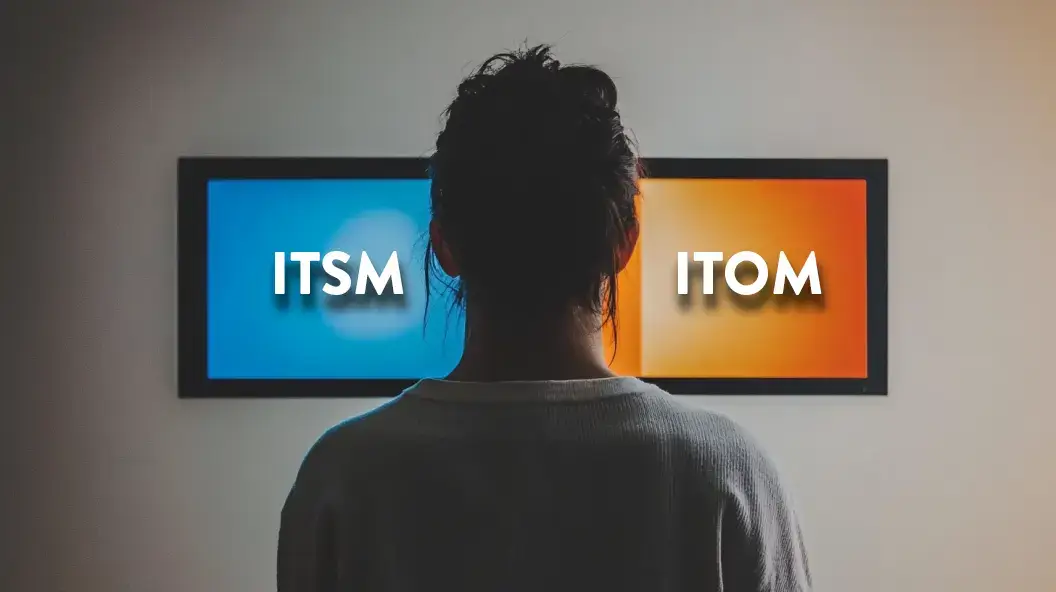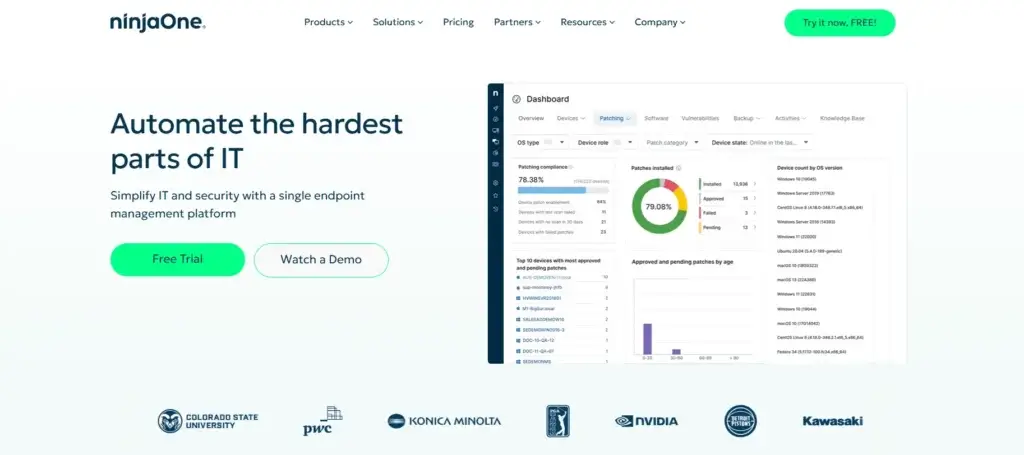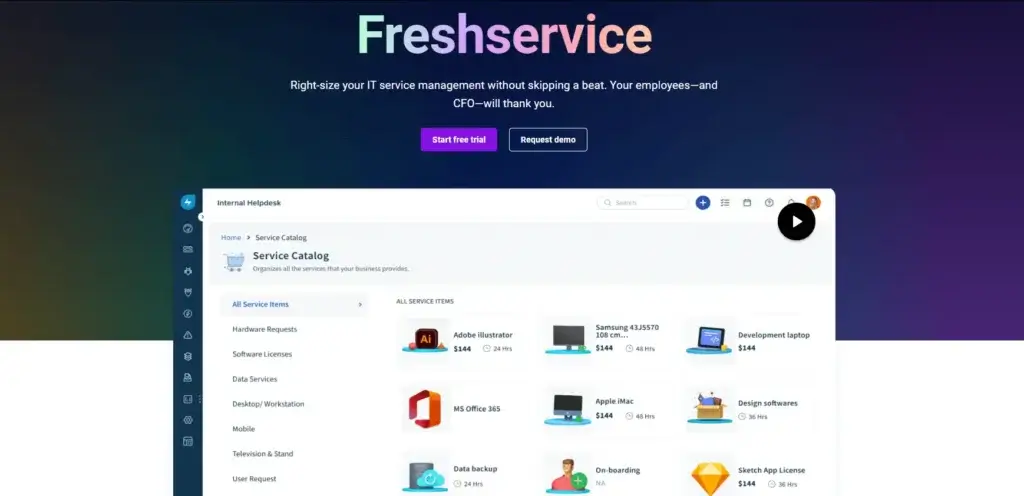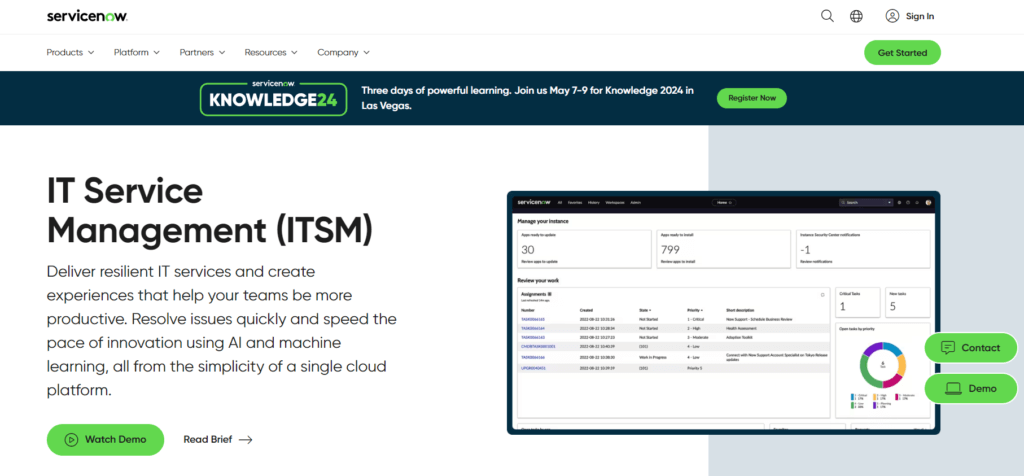
Introduction
As IT environments grow increasingly complex, organizations rely on both IT Service Management (ITSM) and IT Operations Management (ITOM) to maintain efficiency and ensure smooth service delivery. However, ITSM vs ITOM is a common discussion point as these two disciplines are often misunderstood or used interchangeably.
While ITSM focuses on service delivery, incident management, and customer satisfaction, ITOM is dedicated to monitoring IT infrastructure, automation, and performance optimization. Modern IT teams require a seamless integration between ITSM and ITOM to enhance IT visibility, reduce downtime, and improve service quality.
This article explores the key differences between ITSM vs ITOM, how they complement each other, and real-world examples of leading ITSM and ITOM tools, including NinjaOne, Freshservice, and ServiceNow.
What is ITSM?
Definition and Purpose
ITSM, or IT Service Management, is a structured approach to managing IT services in alignment with business objectives. It provides standardized workflows to handle service requests, incidents, changes, and IT assets efficiently.
The primary goal of ITSM is to enhance end-user experience, ensure IT service reliability, and maintain compliance through well-defined processes. ITIL (Information Technology Infrastructure Library) is the most widely adopted framework for ITSM, guiding best practices in service delivery.
Key ITSM Processes and Components
ITSM consists of multiple service-oriented processes, including:
1. Service Desk & Ticketing
- ITSM tools provide a centralized service desk for users to report incidents, request services, and track resolutions.
- Example: Freshservice Incident Management – Uses AI-powered ticket routing and automation to streamline service requests.
2. Change & Release Management
- Manages changes to IT systems to prevent service disruptions.
- Example: ServiceNow Change Management – Offers risk assessment and automated approvals to ensure safe deployments.
3. IT Asset & Configuration Management
- Tracks hardware, software, and cloud assets to optimize resource allocation.
- Example: NinjaOne IT Asset Management – Provides real-time visibility into IT assets for better cost control.
Benefits of ITSM
✔ Improves IT service delivery by standardizing workflows.
✔ Reduces operational costs through automation and self-service options.
✔ Enhances compliance with regulatory frameworks like GDPR and HIPAA.
✔ Boosts user satisfaction with faster incident resolution.
What is ITOM?
Definition and Purpose
ITOM, or IT Operations Management, focuses on managing and optimizing an organization’s IT infrastructure. It involves monitoring system performance, automating IT workflows, and ensuring IT assets remain operational.
Unlike ITSM, which is user-focused, ITOM is infrastructure-centric, ensuring that networks, applications, servers, and endpoints function efficiently. ITOM plays a critical role in reducing downtime, predicting failures, and maintaining IT health.
Key ITOM Components and Processes
1. Network Monitoring & Performance Optimization
- Continuously tracks network performance and detects anomalies or potential failures.
- Example: ServiceNow ITOM Visibility – Provides real-time monitoring of IT assets and dependencies.
2. Automation & Event Management
- Uses AI-driven analytics to predict and prevent service failures.
- Example: Freshservice Workflow Automator – Automates incident response, approvals, and ticket escalations.
3. Endpoint & Patch Management
- Ensures devices and applications are updated to prevent security vulnerabilities.
- Example: NinjaOne Endpoint Monitoring – Offers automated patching and endpoint security to reduce risks.
Benefits of ITOM
✔ Prevents downtime by proactively monitoring IT infrastructure.
✔ Improves performance through predictive analytics.
✔ Enhances security with automated patch management.
✔ Reduces manual workload with AI-driven automation.

Key Differences Between ITSM & ITOM
While ITSM and ITOM are closely related, they serve different purposes within an IT organization. ITSM focuses on service delivery and customer experience, while ITOM is concerned with infrastructure performance, automation, and operational efficiency.
Below is a side-by-side comparison of ITSM and ITOM:
| Feature | ITSM (IT Service Management) | ITOM (IT Operations Management) |
| Primary Focus | Managing IT services & customer experience | Monitoring & optimizing IT infrastructure |
| Key Processes | Service desk, incident management, change management, IT asset management | Network monitoring, automation, event correlation, patch management |
| Main Goal | Improve service delivery & user satisfaction | Enhance infrastructure reliability & performance |
| Operational Approach | Reactive – focuses on handling IT issues as they arise | Proactive – identifies & prevents IT failures before they happen |
| Tool Examples | Freshservice, ServiceNow ITSM, NinjaOne ITSM | ServiceNow ITOM, NinjaOne RMM, Datadog, SolarWinds |
| End Users | IT support teams, helpdesk personnel, employees/customers | IT operations teams, network administrators, system engineers |
Key Takeaways from the Comparison
When considering ITSM vs ITOM, businesses should evaluate their specific IT needs, whether they require structured service workflows (ITSM) or advanced infrastructure automation (ITOM) to optimize IT performance.
- ITSM manages IT services, while ITOM manages IT infrastructure.
- ITSM is reactive (responds to issues), whereas ITOM is proactive (prevents issues before they occur).
- Most ITSM tools include some ITOM features, but full ITOM solutions offer advanced automation and real-time analytics.
- Businesses need both ITSM & ITOM for a fully optimized IT environment.
How ITSM & ITOM Work Together
Even though ITSM and ITOM have distinct roles, they must work together to ensure seamless IT operations. An effective IT strategy integrates both disciplines to improve service quality, reduce downtime, and increase efficiency.
Real-World Scenarios of ITSM & ITOM Integration
1. Incident Management & ITOM Monitoring
👉 Scenario: A critical server failure is detected.
- ITOM Role: ServiceNow ITOM detects an issue with a database server and flags it for review.
- ITSM Role: The system automatically creates an incident ticket in Freshservice, assigning it to an IT technician.
- Outcome: IT resolves the issue quickly, minimizing downtime.
2. Automated Patch Management
👉 Scenario: A software vulnerability is identified.
- ITOM Role: NinjaOne’s patch management detects outdated software on 100+ devices.
- ITSM Role: An automated workflow in ServiceNow creates a change request for approval.
- Outcome: Patches are deployed seamlessly, ensuring security compliance.
3. Change Management with ITOM Visibility
👉 Scenario: Deploying a major system update.
- ITSM Role: ServiceNow Change Management logs and tracks the update request.
- ITOM Role: ITOM monitoring ensures that network and server performance won’t be disrupted.
- Outcome: The update is rolled out smoothly without unexpected service interruptions.
Why Businesses Need an Integrated ITSM & ITOM Approach
✔ Faster issue resolution by automating incident detection & response.
✔ Better decision-making with real-time data on IT performance.
✔ Reduced downtime through proactive monitoring & automated remediation.
✔ Enhanced compliance with audit-ready logs & risk management tools.
ITSM & ITOM Capabilities
To illustrate how ITSM and ITOM function in real-world applications, let’s compare three leading ITSM and ITOM tools: NinjaOne, Freshservice, and ServiceNow.
| Feature | NinjaOne | Freshservice | ServiceNow |
| ITSM Capabilities | Service Desk, Ticketing, IT Asset Management | Full ITIL-aligned ITSM, AI-driven automation | Enterprise-grade ITSM with extensive ITIL support |
| ITOM Capabilities | Remote Monitoring, Patch Management, Endpoint Security | Automated Workflows, ITOM Integrations | Full ITOM suite: AI-based monitoring, cloud discovery, network automation |
| Automation | Script-based automation & policy enforcement | AI-driven workflow automation | Advanced AI & machine learning automation |
| Best For | MSPs & Mid-size IT teams | IT Teams in Enterprises & SMBs | Large Enterprises needing full ITSM & ITOM integration |
| Ease of Use | ✅✅✅ (Simple & fast deployment) | ✅✅ (Moderate) | ✅ (Steep learning curve) |
| Customization | 🔹 Limited | 🔹 Medium | 🔹 Highly customizable |
| Pricing | 💰💰 (Affordable) | 💰💰💰 (Mid-tier) | 💰💰💰💰 (Enterprise-level pricing) |
Which Solution is Right for Your Business?
- If you need a lightweight, automation-heavy ITOM solution with essential ITSM features, NinjaOne is a great choice, especially for MSPs and mid-sized IT teams.
- If you want a balance between ITSM and ITOM with AI-driven automation, Freshservice is ideal for enterprises and growing IT teams.
- If you require full-scale enterprise ITSM & ITOM integration, ServiceNow is the best choice for large organizations with complex IT infrastructures.

Overview
NinjaOne is a cloud-native, unified IT management platform designed for Managed Service Providers (MSPs) and internal IT teams. It offers endpoint management, remote monitoring, automation, and patch management in a single platform. While it is best known for ITOM functions like remote monitoring and management (RMM), it also includes essential ITSM capabilities like ticketing and asset management.
ITSM Capabilities
- Service Desk & Ticketing – Provides a centralized help desk with ticket automation and real-time status tracking.
- IT Asset Management – Tracks hardware and software assets across distributed environments.
- Patch Management – Automates patch deployment for improved security and compliance.
ITOM Capabilities
- Remote Monitoring & Management (RMM) – Monitors system performance, uptime, and endpoint security.
- Automation & Scripting – Uses PowerShell, Python, and Bash scripts to automate IT workflows.
- Backup & Recovery – Offers built-in backup solutions for disaster recovery.
Best For
- IT teams managing remote or hybrid workforces
- MSPs needing automation-heavy IT management
- SMBs requiring an all-in-one RMM & ITSM solution
Limitations
- Lacks full ITIL-based service management compared to Freshservice or ServiceNow.
- More focused on ITOM (monitoring & automation) rather than deep ITSM processes like change management.

Overview
Freshservice, developed by Freshworks, is an ITIL-aligned, cloud-based ITSM platform that provides AI-powered automation, workflow management, and a self-service portal. It is best suited for mid-sized businesses and enterprises that require structured incident, change, and asset management while maintaining flexibility through automation.
ITSM Capabilities
- Incident Management – AI-driven ticketing system with automated categorization and routing.
- Change & Release Management – Ensures safe system updates with impact analysis and approval workflows.
- IT Asset Management (ITAM) – Tracks hardware, software, and cloud assets in a single dashboard.
ITOM Capabilities
- Event & Alert Management – Identifies IT infrastructure issues before they impact users.
- Workflow Automator – Reduces manual work with low-code/no-code automation.
- CMDB (Configuration Management Database) – Helps IT teams track relationships between IT assets and services.
Best For
- Enterprises need a balance between ITSM and ITOM
- IT teams looking for a cloud-native, ITIL-compliant ITSM solution
- Organizations adopting AI-driven service automation
Limitations
- Not as advanced as ServiceNow for large-scale IT operations.
- Limited ITOM capabilities compared to NinjaOne or ServiceNow.

Overview
ServiceNow is a leader in ITSM and ITOM, offering an extensive enterprise IT operations platform that combines ITIL-aligned service management with full-scale IT operations monitoring and automation. It is designed for large businesses, government organizations, and enterprises needing a highly customizable and AI-driven IT management solution.
ITSM Capabilities
- Comprehensive ITIL-based ITSM – Covers incident, problem, change, request, and release management.
- AI-powered Service Desk – Uses machine learning for predictive issue resolution.
- Enterprise-wide Workflow Automation – Integrates with HR, finance, security, and other business functions.
ITOM Capabilities
- Cloud Discovery & Mapping – Provides real-time visibility into cloud and on-premises infrastructure.
- AI-Powered Event Correlation – Reduces noise in alerts by grouping related incidents automatically.
- IT Operations Analytics – Predicts IT failures before they impact business services.
Best For
- Large enterprises with complex IT environments
- Organizations requiring enterprise-wide automation
- IT teams needing deep ITOM analytics & AI-driven insights
Limitations
- Higher cost compared to NinjaOne and Freshservice.
- Steep learning curve for new users due to extensive customization options.

Conclusion
Understanding the differences between ITSM and ITOM is essential for optimizing IT operations. While ITSM ensures structured service management, ITOM enhances system performance and reliability.
A well-balanced IT strategy should not be a debate of ITSM vs ITOM but rather a unified approach where both disciplines work together to improve IT service delivery and operational efficiency.
For businesses looking to build a resilient IT environment, an integrated ITSM-ITOM approach is the way forward. By leveraging tools like NinjaOne, Freshservice, and ServiceNow, IT teams can:
✔ Improve IT service delivery with a centralized service desk.
✔ Enhance operational efficiency with automated monitoring.
✔ Reduce downtime & security risks through proactive IT management.
By integrating ITSM & ITOM, organizations can future-proof their IT strategy, ensuring high availability, security, and seamless IT operations.
🔗 For a deeper dive into ITSM, check out our Complete ITSM Guide and Top ITSM tools.
FAQs
What is the difference between ITSM and ITOM?
ITSM focuses on managing IT services and user interactions, while ITOM is concerned with monitoring, automating, and optimizing IT infrastructure.
What is an example of ITOM?
ITOM includes tools like network monitoring, cloud discovery, and event correlation, such as ServiceNow ITOM, which detects and resolves system performance issues.
Is ITOM part of ITIL?
ITOM is not a separate ITIL module but aligns with ITIL processes like event, problem, and change management to improve IT service operations.
Is CMDB under ITSM or ITOM?
CMDB (Configuration Management Database) falls under both ITSM and ITOM. It helps track IT assets (ITSM) and analyze dependencies (ITOM) for better decision-making.
What are ITOM tools?
ITOM tools include ServiceNow ITOM, NinjaOne RMM, Datadog, and SolarWinds, which focus on network monitoring, automation, and infrastructure management.
How does ITOM improve ITSM efficiency?
ITOM automates incident detection, root cause analysis, and system performance monitoring, reducing the workload on ITSM service desks and improving response times.
Can ITSM and ITOM be used separately?
While they can function separately, businesses achieve better service reliability and operational efficiency when both are integrated for a unified IT strategy.
How do AI and automation impact ITOM and ITSM?
AI-powered automation improves ITOM by predicting and resolving issues before failures occur, while in ITSM, AI helps automate ticket management and service requests.









